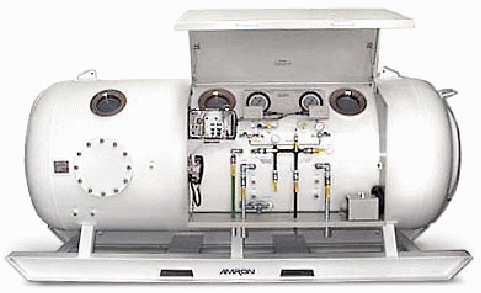For every 10 or so meters that a diver descends into sea water, the pressure increases by about 1 atmosphere. The aqualung diving suit includes a rubber helmet fitted with an opening for the eyes. Air is supplied to a mouthpiece from compressed air cylinders carried on the wearers back. Divers can descend to a depth of about 60 m with the use of an aqualung for a few minutes and to a depth of 45 m for up to 15 minutes. If they were to stay longer, they would be in danger, since at high pressure, nitrogen dissolves in the blood. On returning to the surface where the pressure is much lower, the dissolved nitrogen forms bubbles. When this happens divers experience severe pain, called 'the bends'. In sever cases death may result.
Bends can be prevented or alleviated using a decompression chamber, This consists of a steel tank filled with compressed air. The diver stays inside and the pressure is gradually reduced. Nitrogen is gradually eliminated from the blood without bubbles being formed.

Danger from the bends may be reduced if a mixture of 8% oxygen and 92 % helium is used. Greater diving depths may alos be reached – hundreds of meters.
The opposite problems are experience at high altitude where the pressure is very low. People would die within a few minutes if their were taken to a height of 30,000 feet and left to breathe the low pressure air there. Aircraft flying at these altitudes have pressurised cabins. All openings are sealed and the pressure inside is maintained at a pressure close to atmospheric pressure.
